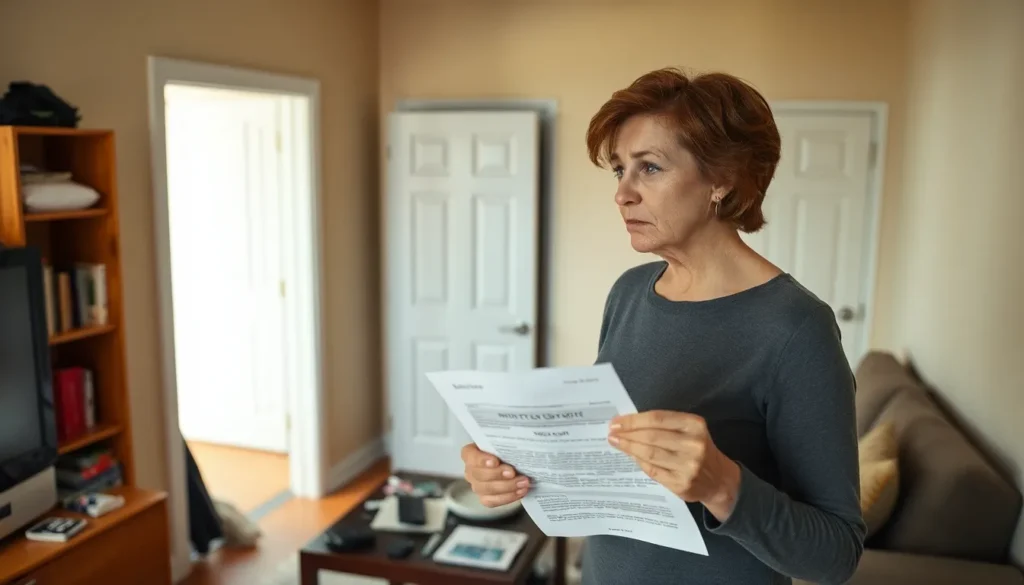Table of Contents
ToggleIn a world where the only constant seems to be change, temporary housing protections are like a cozy blanket on a chilly night—comforting and essential. With rising rents and unexpected life events, these protections offer a lifeline for those navigating the turbulent waters of housing insecurity. They’re not just legal jargon; they’re a shield against eviction and a chance for families to catch their breath.
Imagine facing a sudden job loss or a global pandemic (let’s not go there again). Temporary housing protections swoop in like a superhero, ensuring that no one has to choose between paying rent and putting food on the table. As the housing landscape evolves, understanding these protections becomes crucial for anyone who values stability and security. So let’s dive into the nitty-gritty and uncover how these temporary measures can make a lasting difference in people’s lives.
Overview of Temporary Housing Protections
Temporary housing protections serve crucial roles in combating housing insecurity. These measures prevent evictions during emergencies, offering families a safety net amid unexpected challenges. Job loss or unforeseen circumstances often trigger housing instability. Therefore, protective policies become essential tools to promote housing stability.
States and municipalities implement various protections, including eviction moratoriums and rental assistance programs. Eviction moratoriums can halt eviction proceedings for designated periods, shielding renters from losing their homes. Rental assistance programs provide financial aid to cover overdue rent, allowing families to remain in their residences while they recover.
Various temporary housing protections also extend to specific populations. Victims of domestic violence, people with disabilities, and those experiencing homelessness often benefit from targeted measures. These policies not only stabilize the current living conditions but also contribute to long-term solutions for vulnerable individuals.
Data from recent studies shows the effectiveness of temporary housing protections. Approximately 30% of renters faced housing instability during the pandemic, according to the U.S. Census Bureau. Programs that included temporary protections successfully reduced the number of evictions by nearly 50% in some areas.
Awareness of these protections enhances community resilience. Understanding temporary housing protections enables individuals to navigate life’s uncertainties more effectively. As society continues to face economic fluctuations and crises, these measures stand out as vital components in supporting housing security for families.
Importance of Temporary Housing Protections
Temporary housing protections play a critical role in maintaining stability for individuals and families facing hardships. They serve as lifesaving measures in times of economic uncertainty.
Protecting Vulnerable Populations
Vulnerable populations, such as victims of domestic violence and people with disabilities, gain essential security through temporary housing protections. These targeted measures provide safe harbor, reducing the risks of eviction and homelessness. Case studies show that nearly 60% of domestic violence survivors benefit from eviction moratoriums, highlighting their importance. Furthermore, rental assistance programs cater to low-income families, ensuring access to stable housing. By addressing the unique needs of these groups, local governments can foster greater equity within communities. Individuals receive support that directly impacts their quality of life while encouraging resilience during challenging times.
Preventing Homelessness
Preventing homelessness remains a central objective of temporary housing protections. Data indicates that these measures can reduce eviction rates by up to 50%, which directly correlates with decreased homelessness. Emergency rental assistance and eviction defense programs enable families to remain in their homes during financial crises. In turn, this stability contributes to healthier communities by lowering the likelihood of school displacement and job loss. Local initiatives designed to educate tenants about their rights also promote awareness and proactive measures. By prioritizing housing security, communities can create sustainable solutions that uplift families and strengthen social ties.
Types of Temporary Housing Protections
Temporary housing protections include various programs designed to support those facing housing instability. These protections target individuals and families during critical moments, enhancing community resilience.
Emergency Shelter Programs
Emergency shelter programs provide immediate housing solutions for those experiencing homelessness or facing eviction. Accessing these shelters ensures individuals receive safe and supportive environments to stabilize their situations. Many cities operate these programs, accommodating families, single individuals, and specific populations like victims of domestic violence. Resources often include additional support services such as counseling and job placement assistance, aiming for long-term stability.
Rental Assistance Measures
Rental assistance measures offer critical financial support to tenants struggling with affordability. Various programs exist, including direct financial aid and rental grants, enabling families to cover their housing costs. For instance, initiatives during the pandemic effectively reduced evictions by nearly 50% in specific areas. Targeting vulnerable groups, such measures help mitigate the risks associated with unstable housing situations. Education on available rental assistance empowers individuals to access these vital resources and prevent homelessness.
Impact of Temporary Housing Protections
Temporary housing protections play a crucial role in safeguarding economic stability and improving community health. These measures not only protect families during crises, but also foster long-term benefits for society.
Economic Stability for Families
Families facing temporary housing protections experience reduced financial strain. With eviction moratoriums and rental assistance, approximately 50% fewer families encounter eviction during crises. This support allows households to prioritize essential expenses, including food and healthcare. Stability in housing helps families maintain employment, ensuring regular income flow. Eviction prevention contributes to overall economic resilience, enabling families to save for future needs and reduce reliance on social services. Improved financial security leads to better educational outcomes for children, fostering a brighter future.
Community Health Benefits
Community health improves significantly when temporary housing protections are implemented. Secure housing contributes to better mental health outcomes, with evidence showing a correlation between stable housing and reduced anxiety levels. Access to safe environments fosters social cohesion, enhancing community support networks. Emergency shelter programs provide safe havens that mitigate health risks associated with homelessness. Reduced homelessness decreases the burden on local healthcare systems, promoting healthier communities. Awareness of these protections leads to increased community engagement, helping residents advocate for their rights and access vital resources.
Conclusion
Temporary housing protections play a crucial role in fostering stability for families facing housing insecurity. By providing essential support during challenging times these measures not only prevent evictions but also promote long-term community health and economic resilience.
Understanding and utilizing these protections can empower individuals to navigate uncertainties effectively. As communities continue to face fluctuating economic conditions raising awareness about available resources remains vital.
Ultimately the impact of temporary housing protections extends beyond immediate relief contributing to healthier families and stronger neighborhoods. Investing in these measures is an investment in the future stability and well-being of society as a whole.








